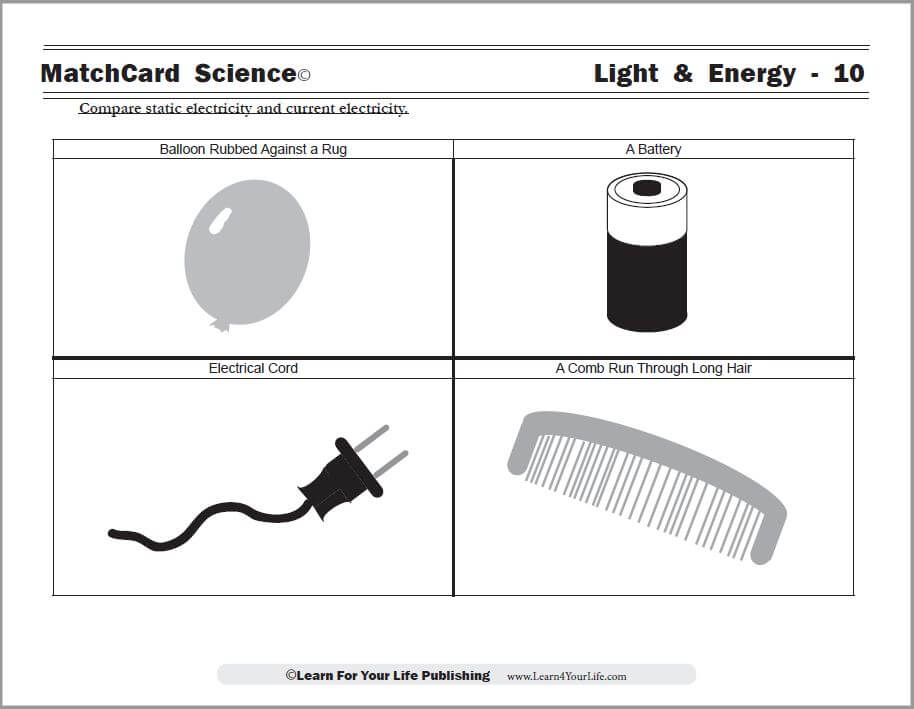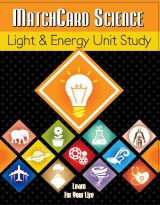Static Electricity
The Static Electricity worksheet from MatchCard Science compares static and current electricity and guides students' exploration of negative charges.
Free Download Below


What is Static Electricity?
Objective: Compare static and current electricity.A static charge is a negative charge that stays on the surface of an item. It occurs because electrons attached to the surface of the object. The negatively charged object then attracts other objects.
This MatchCard compares static and current electricity. You may want to review the Electrical Circuit MatchCard (MatchCard #9) in order to compare static and current electricity.
MatchCard: Download below.
Print the Static Electricity MatchCard


Click image to go to download.
This is MatchCard #10 of the Light and Energy Unit Study. Find more information on MatchCard Science below.
Activities
Get a Charge
First we want to charge the surface of an object. Here are some common objects used for these demonstrations:- inflated balloon (latex)
- plastic comb
- glass rod
How do we charge these objects? You will need to rub the object against an object that is usually already charged. Here are common objects:
- long human hair
- wool sweater
- many carpets and rugs (some synthetic materials do not work as well)
- silk cloth
Let's Experiment
Here are some fun ways to demonstrate static electricity:- Have a charged balloon stick to a wall. Count how long it sticks. How hard do you have to blow to move it?
- Turn on the tap water so a small but steady stream of water is coming from the faucet. Move the charged object (like the comb or rod) to the stream. The electrical charge causes the water to bend towards the object.
- Scatter small pieces of tissue paper on a table. Run the balloon, comb, or rod over it. The papers will jump up to stick to the object.
- Hold the object several inches above someone's hair. The hair stands straight up.
- Tie a 12 inch piece of thread or toothfloss to an O shaped piece of breakfast cereal. Move the object towards it. the cereal will be attracted. Continue moving it towards and away from the cereal. Once the cereal becomes charged, it will move away from the object because like charges repel.
- Mix 1/4 teaspoon of salt and 1/4 teaspoon of pepper into a little pile. Ask the student how they might separate them. Slowly, move the balloon or rod over the pile. The lightweight pepper will be attracted to the charged object.
- Blow bubbles in the air using a bubble solution or dish soap. Use the charged comb or rod to attract the bubble. Have a contest to see who can keep the bubble floating the longest as it follows the comb.
Get Charged
Gets a Positive Charge
These materials give up their negative electrons (resulting in a positive charge on their surface)Listed in the order of greatest ability to give up electrons to least ability
- Dry skin
- Leather
- Rabbit Fur
- Glass
- Human Hair
- Nylon
- Wool
- Pepper
- Cat hair
- Silk
- Aluminum
- Paper
Gets A Negative Charge
These materials accept new electrons (resulting in a negative charge on their surface)Listed in order of greatest ability to accept more electrons to least ability to accept new electrons
- Teflon
- Vinyl and PVC pipes
- Saran Wrap
- Styrofoam
- Polyester
Neutral Charge
Cotton is a neutral material: it neither accepts or gives up electrons.Acrylic (plexiglass) and wood are almost neutral. They can become charged with friction.
Using Friction Rods
Friction rods can be made or purchased for static electricity experiments.Glass Rods - Your glass rods have a tendency to give up their negative electrons and become positively charged. Use them with the items on the negative list (like styrofoam.)
Rubber - Rubber rods have a tendence to accept electrons and become negatively charged. Use them with items in the positive list (like nylon, fur, or human hair.)
Plexiglass - Plexiglass or acrylic rods are neutral so technically can be used with positive or negative items.
Three Step Plexiglass Rod Demonstration
1. Scatter pieces of tissue paper on a table top. Touch them with your neutral acrylic rod. Nothing happens. (You can also use pepper rather than tissue paper.)2. Rub the acrylic rod with fur, silk, or wool. The acrylic takes electrons from the cloth and has a slight negative charge.
3. Touch the negatively charged rod to the tissue paper. The positive paper will stick to the negative rod.
It won't take long for the rod to become neutralized again as those extra electrons on it find some other place in the environment to go.
MatchCard Science
How To Use MatchCards

Download the FREE MatchCard Science Instructor's Guide and see how MatchCards can make building their science knowledge base fun.
Light and Energy Unit Study

Download the entire Light and Energy unit study.
12 Science Unit Studies

Chemistry is only one of twelve complete unit studies for kids in 3rd to 8th grade.
Comprehensive objectives, hands-on projects, suggested science fair experiments, and the fun game-like MatchCards keep them interested in learning science. See all twelve MatchCard Science Unit Studies.
About Our Site
Hands-On Learning













